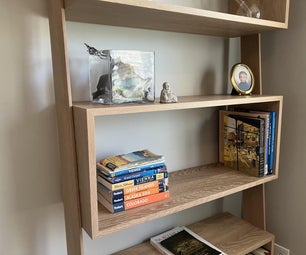Introduction: Minimal Document Mirror
This device is intended to be a low-cost alternative for sharing handwritten work during video calls. Unlike many existing designs for 3D printed document cameras which use 2" mirrors, this one uses a 1" mirror which makes it more convenient to use while still managing to get an entire 8.5"x11" sheet of paper in frame. It is a universal design which should work with most laptops; the clip is compliant and can bend to match the shape of the laptop lid. In addition, the angle and vertical position of the mirror is adjustable with a thumb screw in order to optimize the mirror position for whatever laptop it's used on. We've included two versions of the mirror holder part of the device to accommodate the different mirrors that may be available - some have adhesive backing while others require mechanical fastening.
Supplies
- PLA for 3D printing. Each complete document mirror uses approximately 5 grams of filament.
- 1" mirror tiles from Amazon, $12 for 120 of them. Any 1" tiles should work as long as they are around 1-2mm thick.
- M3 thumb screws from Amazon, $9 for 30 of them.
- M3 nuts from Amazon, $7 for 100 of them.
Each document mirror uses one of each of the mirrors, thumb screws, and nuts, resulting in a cost per device of $0.60, assuming a 1kg roll of PLA costs $25.
Step 1: 3D Printing
First select the appropriate STL file for your usage. The "slide" versions of the files should be used if you have mirrors without adhesive backing (e.g. those linked in the supplies), in the 1-2mm thickness range. The "adhesive" versions of the files should be used if you have adhesive backed mirror tiles. We've also included STL files with 40 document mirrors tiled for mass production.
Printing Parameters:
- Locate the parts on the printing plate as shown. They should be printed in PLA without supports. We haven't tested other types of filament but the clip relies on the elasticity of the material so others might not work.
- The extrusion width should be 0.5mm since most features of the part are 1mm in width and are intended to be constructed in 2 passes of the extruder.
- Infill should be 100%. Most features are thin anyway but this will ensure the proper strength at the fastening location between the parts.
- Layer height isn't critical - we've tried 0.2mm and 0.3mm and they both worked fine.
Finally, once you have generated the tool-paths for the 3D printer, check to make sure that the corner of the clip marked in red will come out as sharp as possible. When in use, this catches on the lip of the laptop lid so it needs to be sharp in order for the clip to hold securely.
Step 2: Attaching the Mirror
If you have mirror tiles with adhesive backing, simply stick the mirror to the face of the mirror holder as shown in the first image. If using the slide variant of the design, slide the mirror into the slot in the mirror holder as shown in the second image.
Step 3: Assembly
First press the M3 nut into the hexagonal pocket in the mirror holder part. Then, using the thumb screw, fasten the clip and the mirror holder together as shown in the diagram.
Step 4: Using the Document Mirror
First clip the document camera to the lid of your laptop, with the cutout in the clip centered over the webcam. Then, turn on the webcam, loosen the thumb screw, and adjust the mirror so that you can see your entire document. The mirror can be adjusted in both its vertical position as well as its angle. The angle of the computer lid - how open or closed it is - can provide a third point of adjustment to fine tune the frame of view. Once the document mirror is adjusted for your particular laptop, tighten the thumb screw. The document camera can now be removed and clipped on again as needed without having to go through the adjustment process.
Mirroring the Video Feed with Zoom:
Zoom seems to be the preeminent video calling software these days but, as of this writing, it doesn't actually have a way to mirror the video feed. It does have an option which mirrors the video feed that you see, but this doesn't change what others on the call see so your writing will still be reversed for them. We've gotten around this by using the free virtual webcam software ManyCam which acts as a middleman between the webcam and Zoom - you can mirror the video within ManyCam and use ManyCam as the video feed for Zoom in order for others on the call to see your writing the right way around. There are probably other options out there but this could be a good place to start if you encounter this problem.

















